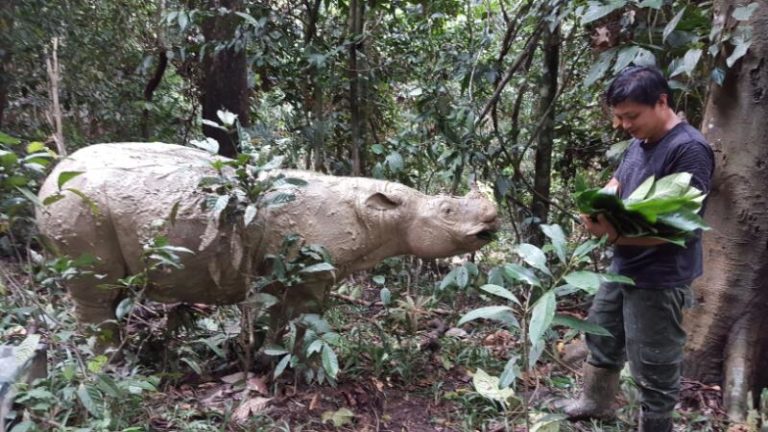- Puntung was one of three Sumatran rhinos known to survive in Malaysia, and one of fewer than 100 representatives of this Critically Endangered species.
- Her health first raised concern in March, when she was found to suffer from an abscess in her jaw.
- Dental surgery was successfully performed in April, but she was then found to have squamous cell cancer.
- Veterinarians determined the disease was fatal and that treatment would only prolong her suffering. Puntung was euthanized just after dawn on Sunday, June 4.
Sumatran Rhino Puntung was euthanized early Sunday morning after being diagnosed last month with terminal squamous cell cancer.
“Today is one of the saddest days we’ve ever faced,” the Borneo Rhino Alliance (BORA) wrote in a June 4 statement. “As of this morning, Puntung’s suffering has come to an end.”
Puntung was one of only three Sumatran rhinos (Dicerorhinus sumatrensis) known to survive in Malaysia. A female believed to be around 25 years old, she was captured in the wild in Malaysian Borneo in 2011 and lived the rest of her life at the Tabin Wildlife Reserve in Sabah, a fenced-in facility managed by BORA.

Overall, between 55 and 100 of the Critically Endangered species are believed to remain. Two live at the Tabin facility, with the rest in Indonesia. These rhinos live in small, isolated groups, and experts including BORA Executive Director John Payne point to low birthrates as the single greatest threat to the survival of the species, outweighing the dangers of poaching or habitat loss.
Researchers had hoped Puntung might be able to contribute to a captive breeding program to boost the Sumatran rhino’s dwindling population. However, like the other two rhinos at Tabin, she was found to be unable to reproduce naturally. Puntung did still produce eggs, prompting hopes that she could perhaps reproduce via in vitro fertilization, the merging of sperm and eggs in a laboratory.

Rapidly deteriorating health
Veterinarians were alerted to Puntung’s cancer after she was found in mid-March 2017 to suffer from an abscess in her upper left jaw, attributed to dental problems. Initially, Puntung’s carers feared she would not survive an infection related to the abscess, but surgery was successfully completed in April.
However, the rhino’s carers discovered that the facial swelling that alerted them to the dental problem “had a more serious origin,” BORA announced on May 31. “Puntung is dying of cancer.”

The cancer was found to be spreading and specialists concurred that the disease would be fatal with or without treatment, BORA added. “We have kept in close touch with experts in Europe, South Africa and Thailand, and there is no doubt in our minds that any form of conventional treatment would just prolong her agony.”
The government authorized euthanasia, originally scheduled for June 15. Researchers had hoped to keep the rhino comfortable until her eggs or oocytes could be retrieved, a plan aimed to help preserve diverse genetic material for this critically endangered species.
However, Puntung’s condition deteriorated rapidly — by the end of May she was in pain, unable to vocalize and could not breathe through her left nostril — and carers made what they described as “the very difficult decision of ending her suffering and giving her peace.”
FEEDBACK: Use this form to send a message to the author of this post. If you want to post a public comment, you can do that at the bottom of the page.